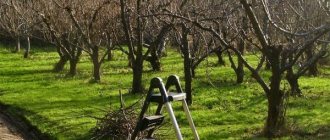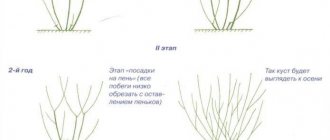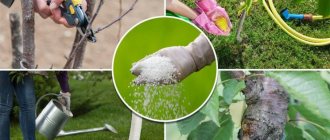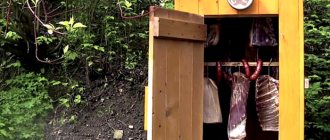Many summer residents, flower growers and simply owners of country houses want to improve their local area. Flower beds with flowers that delight you with their appearance and pleasant aroma are the best solution even for a small area. Rose gardens look especially attractive in gardens - places where one of the most beautiful flower crops grow - roses.
As the French writer Antoine de Saint-Exupéry said, roses have a difficult character, and therefore their cultivation requires some effort and investment.
Autumn pruning of roses for the winter is an integral part of caring for these delicate plants. Now is the time to think about it and figure out how to help the plants in your area. An experienced gardener knows how to approach his plantings and works confidently in the garden. And for those who dream of a rosary and are just beginning to take their first steps in mastering this art, the advice given in this article will be excellent helpers.
Is it necessary to prune roses in the fall?
Formative pruning is done in the spring, but plants also need favorable conditions for wintering. The simplest protection for roses is covering. This way you don’t have to worry that the flowers will die. For convenience and high-quality insulation, the branches are shortened.
Also, this method does not allow the spread of diseases that occur on the remaining buds, branches and leaves.
Rose bush after pruning
In addition, this way the roots will absorb nutrients faster and thereby become stronger. And this directly affects the size and brightness of future buds. As a result of the work, the rose bushes will remain healthy, prepare for wintering and will delight you with lush flowering in the spring.
Advice! Pests also love warmth, and plant debris and fallen leaves are an excellent refuge for enemies of any cultivated vegetation. Along with pruning, be sure to tidy up the area around the rose bushes.
Timing of autumn pruning
It takes time for the plant to enter a state of dormancy, which slows down all life processes. Typically, this period begins when the temperature outside is above five degrees during the day and below zero at night.
Roses are grown in different climatic zones, so it is difficult to determine universal timing for pruning plants. The start time of the procedure depends on weather conditions.
Of course, it is easiest for residents of the southern regions to grow flower crops. There the climate is mild, and frosts, destructive for fastidious plants, are rare. Therefore, pruning can be done in November, but covering it is completely pointless. It is enough to sprinkle the base with sawdust to insulate the roots.
In the Middle Zone and the North-West, branches should be removed from the second half of October (from about October 15), in warm and dry weather.
Residents of the Urals and Siberia should begin work at the end of September. With the arrival of October cold, the bushes should already be insulated and covered.
Advice for beginners! It is very important to pay close attention to the timing of “sanitary cleaning” of bushes. After all, if you start work too early, the shoots will begin to grow, and this will lead to weakening of the plant and even to its death.
Transplanting rose bushes
September-early October is the best time to replant roses. The first in line to change their place of residence should be weak roses that have responded poorly to care throughout the entire growth period. For new residents of your rose garden, it is also better to find suitable places in the fall:
The process of transplanting roses is as follows:
- Choosing a sunny, open place for flowers;
- Marking and preparing holes for planting. Miniature roses can be planted thicker (40-50 cm between bushes), climbing and bush varieties require sparse plantings - 1-1.5 meters. The standard size of the holes is 50x50 cm;
- Preparation of nutrient soil mixture. Peat, sand and compost are taken in equal proportions. The soil for roses can be diluted with clay. Ash, bone meal and other nutritional components are added to the finished mixture;
- Planting seedlings. Pre-soaked seedlings are lowered into the holes with their roots, the roots need to be straightened. The bush is covered with earth and watered thoroughly. When the water is absorbed, the young roses need to be spudded.
What to prepare in advance?
To speed up work and increase productivity, you need to prepare. Suitable tools and clothing will make the job easier.
Thick, durable gloves, thick garden trousers, and a long-sleeved jacket will provide good protection for your hands and feet from thorns.
When pruning roses, you must wear protective equipment and use special gardening tools.
A sharp pruner or scissors is suitable for this work.
Important! Transferring an infection from one branch to another is a common problem. Experienced gardeners recommend disinfecting tools with a solution of potassium permanganate or phytosporin. You just need to periodically dip the pruning shears in the liquid and continue working.
The cut areas are usually treated with garden pitch, coal or putty. This way the plant will not be afraid of fungus, insects and pests.
Caring for roses in September
At this stage, you must adhere to the following rules:
- We stop trimming roses for bouquets, as this stimulates the growth of new buds. For young roses that you did not allow to bloom in the summer, you need to leave the last inflorescences and let them ripen;
- Reduce watering. If September is hot and dry, you can water your roses once a week until the middle of the month. After watering, we do it once every 2 weeks and completely stop watering the rose garden by the end of September;
- We replace growth-stimulating nitrogen fertilizers with potassium-phosphorus fertilizers. This way we will strengthen the root, and the plant will better survive the cold. We often don’t feed roses; two feedings are enough.
Your actions this month:
I. Feeding the roots with a potassium phosphate composition
You can scatter dry granules near the roots and lightly compact them into the soil, or you can prepare a liquid solution (see tips above) for watering or spraying the green part of the roses.
II. Last loosening of the soil
It is better to do it immediately after feeding the bushes. This may allow the last rosebuds to ripen faster.
III. Limited watering
Ideally, roses should be watered twice in September - at the beginning and towards the end of the month. If September is not dry, then there is no need to water the rose garden additionally.
IV. Weeding
All young weeds should be removed from the rose garden. They can become a source of infections.
V. Removing the lower foliage of roses
Leaves are also often affected by infections; moreover, their presence can stimulate photosynthesis and prevent the rose from slowing down metabolic processes. All leaves up to a height of 20-30 cm must be removed.
VI. Stem processing
After removing the foliage, bare stems should be painted with garden varnish, water-based solution or other disinfectants. This will protect the bushes from rot and pests that are looking for a place for the winter in the stems of plants.
How to prune different varieties of roses
The species diversity of roses is wide. The characteristics of the variety influence the ways in which plant crops are prepared for hibernation. Therefore, a novice gardener, before starting gardening work, should remember the name of the varieties planted in the garden.
The most popular types are:
- "Floribunda";
- "Hybrid tea";
- "Climbing";
- "Park";
- "Ground cover";
- "Bush".
The listed types differ in shape, shade, number of buds themselves, height of the bush and a number of characteristic advantages and disadvantages. The procedure should be carried out adhering to general recommendations and taking into account some features of caring for different varieties.
How to prune a Floribunda rose for the winter
Floribunda roses have lush and numerous inflorescences, and so that next year’s flowers do not lose their merits and the shoots grow strong, pruning this bush in the fall is mandatory.
But you need to remember the following:
- active removal of all excess is not suitable for this variety, since
- new flowers will form from previous shoots;
- Bushes need to be trimmed after flowering is complete;
- shorten strong shoots by half and leave 3-5 buds;
- cut young stems by a third, do not remove up to 10 buds
- remove old shoots in the center of the planting.
Pruning “Hybrid Tea” roses in autumn
Caring for the “hybrid tea” species is almost no different from pruning the previous one. Necessary:
- cut into a spherical shape;
- remove weak shoots growing deep into the bush;
- cut strong shoots by 12, young shoots by a third.
Trimming “Climbing” Roses
Sanitary treatment of “climbing” varieties with small flowers does not require pruning at all. And large-flowered bushes are shortened only in the second autumn after planting. And it is recommended to do this by following these rules:
- cut branches by a third;
- When flowering, remove shoots by three buds;
- trim old branches to leave 30 cm from the root.
Prune “Park” roses for the winter
“Park” ones, like “climbing” ones, do not need to be shortened. It is enough just to perform the so-called pinching, that is, removing only the upper shoots, buds and buds located at the end of the branch. You can also remove old, damaged or diseased growths.
"Ground cover"
When caring for “ground cover” plants, you need to follow general advice. Side shoots are a feature of these varieties.
They are shortened by two or three buds. Also in the middle of the flower culture, the branches can intertwine with each other, but for convenience they should also be removed.
"Scrubs" or "Bush"
“Bush” is also called scrubs. This type of pruning scheme:
- leave the strongest shoots, which have 6-8 buds, and the remaining healthy and symmetrical branches
- dry, diseased, damaged, remove completely
- trim off thin, very young shoots
- all others should be shortened by a third.
Preparing roses for winter
From the beginning of August, the application of nitrogen fertilizers to the soil is stopped, but just at this time it is necessary to carry out the first strengthening winter root feeding of roses, which consists of 25 g of superphosphate, 2.5 g of boric acid (or 3.5 g of borax) and 10 g of sulfate potassium dissolved in 10 liters of water. This amount of solution should be enough for 4 m² of area. The second strengthening fertilizer is applied to the soil a month later - at the beginning of September: 16 g of potassium sulfate, or potassium monophosphate, and 15 g of superphosphate are dissolved in 10 liters of water.
But it is better to carry out foliar treatments of roses instead of root treatments - spray the bushes on the leaves with the same solutions, but in a concentration three times less than with root feeding.
From the beginning of autumn, they also stop loosening the soil under the bushes, so as not to provoke the growth of shoots from dormant buds, and from mid-September, they pluck out all the buds that are smaller than a pea, and those that are larger in size are allowed to ripen and form fruits.
- How to take grape cuttings for rooting: there are 3 methods - which is the most effective?
In the photo: Trimmed rose bushes before wintering
What to do after?
It is recommended to treat the plant after all of the above procedures. The choice of product depends on the climate. There are two options:
- in cold weather (below +5), iron-containing preparations are used;
- at temperatures above +6 - copper-containing substances.
Important! Iron sulfate at warm temperatures can burn the bushes, and copper preparation at low temperatures will be useless.
After all the procedures, all that remains is to wrap the bushes, which will provide favorable conditions during winter “hibernation”.
Planting a plant in the garden
It is recommended to purchase grafted planting material in the autumn months. The roots should be covered with moss or peat and wrapped in film. Plants can be easily preserved until planting. It is important that they are stored in a cool place.
Landing place
For roses, you should choose a comfortable place on the site that is well lit and not blown by the wind. It is best to plant plants in the southern part. The substrate must be loamy and neutral in acidity. The soil for planting is first fertilized with organic matter. There should be no groundwater near the surface.
Proper preparation of soil for scrub roses
The soil for the future rose garden should be sorted out and cleared of debris and weed roots. 14 days before planting the seedlings, the soil should be dug up. The day before planting, holes should be dug in the garden bed. Rotted mullein and compost should be added to each hole. Additionally, you can enrich the soil with ash.
Landing period
The planting time depends on the climate zone; for example, in the southern regions of the country, roses can be planted in the first days of autumn. A month before frost is enough for the plants to have time to grow and not freeze in the winter.
In areas with colder climates, planting should be postponed until spring. If the root system of the seedling is closed, then planting is best done in spring or autumn. With the roots covered, plants can be planted from spring to autumn.
Video on how to properly prune roses for the winter
After watching the video, you will find out why autumn pruning of roses is needed, and whether all varieties need to be pruned. What are the features of this procedure, secrets and tricks that will help prepare rose bushes well for winter. Join the viewing!
Caring for roses is not an easy task. And it seems that it is difficult for an inexperienced gardener to follow all the nuances. But, most importantly, make an effort and put your soul into what you love. And then the proud beauty - the rose - will thank her caring owner and will delight in the spring with lush flowering and great fragrance
Tools for work
To carry out the procedure you will need the following tools and materials:
- pruning shears (it is better to use a tool with two cutting edges: it is a little more difficult to use, but it remains sharp much longer);
- electric emery or other tool for sharpening pruners (if necessary);
- a garden saw, garden knife, long-handled garden shears or delimber for cutting thick stems;
- thick gloves;
- mat for knees;
- alcohol or potassium permanganate for disinfecting garden tools;
- garden pitch or Novikov liquid for processing cuts;
- copper sulfate 1% for subsequent treatment of the entire bush.











